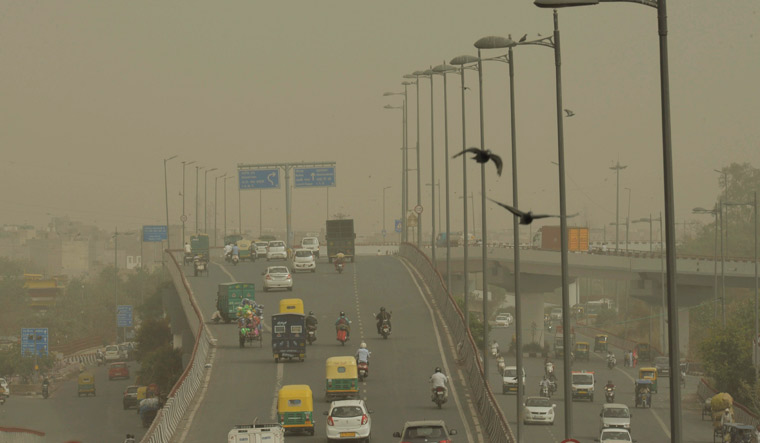A thick blanket of haze enveloped Delhi and parts of the National Capital Region (NCR) with the Environment Ministry on Wednesday predicting that the dusty conditions, a fallout of dust storms from Rajasthan, were likely to prevail over the next three days.
High pollution levels in Delhi are mainly due to the dust storms from the desert state, the ministry said after air quality in the national capital deteriorated beyond "severe" level on Wednesday.
It has also alerted major construction agencies, municipal corporations and Delhi Pollution Control Committee (DPCC) to ensure water sprinkling, and asked Delhi's Chief Secretary to issue appropriate instructions in the matter to the agencies concerned.
The Central Pollution Control Board (CPCB) also convened an urgent meeting of the Task Force regarding implementation of Graded Response Action Plan (GRAP) today and issued necessary directions to contain local dust sources.
The air quality in Delhi deteriorated beyond the "severe" level because of a ground-level dust storm in western India which increased coarser particles in the air, the Central Pollution Control Board data showed.
The CPCB data showed that the PM10 (particles with diameter less than 10mm) level was beyond "severe" at 778 in Delhi-NCR area and 824 in Delhi particularly, leading to hazy conditions and limiting visibility.
The CPCB said the pollution of this season was very different from that of last year. In November last year, both PM2.5 and PM10 had spiked which was posing serious health hazard. However, the current increase in levels of pollution is mainly due to drastic increase in coarse particles in air which has caused a spike in PM10 level but PM2.5 is not as high as that of last year.
"The high pollution levels during this time of the year in Delhi are unusual and primarily due to dust storms from Rajasthan. Rajasthan is facing extremely dry weather conditions, with high temperatures and wind speeds," a ministry statement said.
It said the wind direction in Delhi since June 10 has changed to West and North West and then since June 12 to West and South West, due to which hot air, along with dust from Rajasthan has started moving into Delhi.
According to the India Meteorological Department (IMD), the current surface winds in Delhi are in the range of 5-6 m/sec and wind direction is West to South West, which is likely to continue over the next three days.
"Therefore, it is expected that dusty conditions will prevail in Delhi over the next three days. Major construction agencies, municipal corporations and Delhi Pollution Control Committee (DPCC) have been alerted to ensure water sprinkling, as required," it said.
The Environment Ministry has requested the Chief Secretary, Delhi to issue appropriate instructions in the matter to the agencies concerned, it said.
"CPCB convened an urgent meeting of the Task Force regarding implementation of Graded Response Action Plan (GRAP) today (Wednesday) and issued necessary directions to contain local dust sources. The Task Force has also recommended that public should avoid prolonged exposure," the Ministry said.
Gufran Beig, a scientist at the Centre-run System of Air Quality and Weather Forecasting and Research institute, said the dust storm deteriorated the air quality in Delhi-NCR.
"There was a ground-level dust storm in the western part of the country that increased drastically coarser particles in the air, causing a spike in pollution levels in Delhi," he said.
According to CPCB, the air quality index at several places in Delhi crossed the 500-mark, with east Delhi's Anand Vihar area recording an AQI of 891.
An AQI between 0-50 is considered Good, 51-100 Satisfactory, 101-200 Moderate, 201-300 Poor, 301-400 Very Poor, and 401-500 Severe.

